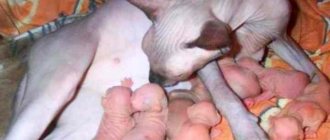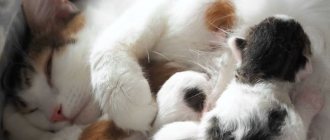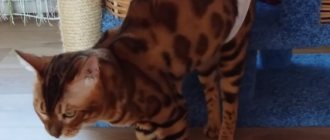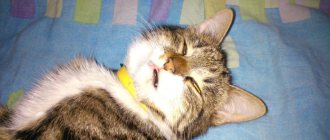Why does a cat refuse offspring?
For no reason, a mother cat will not stop caring for her kittens. There are quite logical explanations for atypical behavior:
- The presence of the disease in the “parent” . In most cases, refusals are due to the fact that the cat has a disease such as mastitis. This is not difficult to determine. You need to examine your nipples very carefully. Inflammation, redness and swelling, severe pain when touching the nipples are a symptomatic picture of mastitis. With such a disease, you should immediately contact a veterinarian. Without treatment it will only get worse.
- Postpartum weakness . This phenomenon tends to happen frequently with young cats. Signs: lethargy, nausea and vomiting, elevated body temperature are indications for immediate consultation with a doctor. Due to a suppressed immune system, the animal’s body is too vulnerable to viruses and infections, which can lead to serious consequences.
- Exhaustion . Signs of exhaustion and dehydration of a cat are its extreme thinness, in which the bones are visible and the skin can be gathered into folds. In this condition, the animal should be urgently taken to a veterinary clinic.
- Manifestation of the “fading kitten” syndrome . Cats are primarily predators who originally lived in the wild, where life dictates its own rules. A cat will not care for a kitten born weak and sick. She will devote her energy to raising strong individuals capable of surviving in the wild. A weak kitten will have to be taken into care by a person.
- Numerous litters . A cat is not able to feed a litter of more than 6 kittens.
- Childbirth at an early age . There are often situations when a cat becomes pregnant during a period when puberty has not been completed. Accordingly, her parental instinct cannot fully manifest itself. As practice shows, if cats abandon their offspring, they do so after the first birth.
- Psycho-emotional disorders . It’s not just human touching kittens that can cause a cat to abandon them. Stress in a cat will be caused by any human intervention in her personal space after giving birth - replacing the bedding in the box, changing its location, directing too bright light to the “nest”. Within 2-3 days after birth, you should not approach the nest where the cat is located unless necessary.
- Hormonal changes. Due to the hormonal surge during pregnancy, the cat may not have milk, and therefore the maternal instinct will not appear. If there is no milk, you can try to stimulate it, for this you need to contact a veterinarian.
It is often the person’s own fault that a cat abandons its offspring.
It is strictly forbidden to pick up a newborn baby or even touch it.
Tactile contact should also be limited with the cat that has given birth.
How to care for kittens
Babies left without parental care need not only proper feeding, but also full care. A person must do everything so that the newborn pet does not feel inferior and receives the proper warmth, attention and affection. Functions of a cat that a person should take on:
- Heating . Kittens lack thermoregulation function. It is important for the baby to equip a “prototype nest”. A box is suitable for this, the bottom of which will need to be covered with a warm cloth. It is better to choose woolen materials that will remind your baby of touching his mother’s wool. Place heating pads with hot water on each side of the box.
- Hygiene . The cat carefully monitors the cleanliness of her cubs, constantly licking them. Therefore, a person should do the same - before each feeding, the kitten should be examined so that there are no inflammations or abscesses on its fur and skin. After feeding, wipe the fur with a damp, sterile cloth. Inspect the tray regularly and clean it as necessary.
- Massage . After feeding, you need to gently massage your tummy with a cotton swab. This will help improve digestion and stimulate the urination process.
The biggest challenge that a person caring for a newborn kitten faces is feeding. To feed kittens, you can use specialized formulas sold in pet stores, or prepare them yourself.
The cat abandoned the kittens - how to arrange the place of detention?
If, nevertheless, the cat left the kittens, the best option is to invite a donor, or a surrogate mother. But most often this is not possible. Then you will have to take care of the kids yourself.
The cat abandoned the kittens, how to arrange the place of detention:
- At the first stage, you need to prepare a house for them. This could be a shoebox lined with soft, warm material. It could be a wool blanket. Please note that the house must be spacious enough.
- It is necessary to divide it into two parts, put bottles of hot water in one, cover with a blanket, the second part of the house should be without bottles. This is necessary if the kittens suddenly become hot.
- The temperature of the bottled water should be approximately 37-40 degrees. The optimal temperature for nursing kittens is 30 degrees. It is at this temperature that cats keep their babies. Next, you must also ensure that the place is secluded and secluded.
- There is no need to allow children to constantly carry babies in their arms. This can affect their health and even cause death. Contact with people is stressful for babies. Regular feeding is required every 2-3 hours.
Notice that the cat in the nest is constantly licking her kittens, cleaning them.
Kittens
Feeding methods
There are several ways to feed a newborn baby with formula or milk substitutes:
- From a spoon , however, this method is used extremely rarely in practice, since it is very inconvenient and is suitable for slightly older animals.
- From a pipette - convenient to use for feeding, as it imitates a cat's nipple, allowing the kitten to develop a sucking reflex.
- From a syringe – this method of serving food to the kitten is given the greatest preference. Using a syringe, it is easy to dose the volume of food, and the kitten is comfortable, since the nose of the syringe is similar to a nipple. The needle is not put on the syringe when feeding.
For feeding, there are special tubes inserted directly into the animal’s stomach. But using such a device without certain skills and abilities is strictly prohibited.
Feeding formulas
Kittens can be given formulas intended for children. These are the well-known products Malyutka and Malysh, Nestozhen, Nutrilon. Prepare them according to the instructions. There are 2 simple recipes for preparing a nutritional mixture, but it is important to follow all dosages:
- cow's milk, homemade – 50 g;
- powdered milk – 15 g;
- dry nutritional yeast – 3 g;
- egg - 50 g of white with yolk and 50 g of foam from a beaten egg;
- 1 g sunflower oil;
- 4 g pharmaceutical glucose.
The ingredients are mixed (only in a ceramic container) until they have a homogeneous consistency. The finished mixture is drawn into a syringe.
Another kitten formula recipe:
- 25 g homemade milk;
- 5 g milk powder;
- 2 g glucose;
- 1 g vitamin supplements.
The ingredients are mixed. Vitamin supplements in tablet form must be ground into powder in advance and added to the rest of the ingredients.
Ready mixtures can be stored in the refrigerator for no more than 3 days from the moment of their preparation.
Ready-made artificial substitutes . The best food for a newborn is ready-made cat milk substitutes. Recommended brands:
- Pet Lac;
- Nutri Vet;
- Babycat Milk;
- Beapher Kitty-Milk.
The only drawback of artificial milk substitutes is the likelihood that the baby will have allergic reactions to the chosen product.
What you need for feeding
To feed your pets you need to purchase everything you need.
What you need to feed a kitten:
- Special mixtures, nutrition.
- Cat milk substitutes.
- Pipette, disposable syringes without a needle or with a rubber nozzle;
- Bottles with nipple. Use the Catac kitten feeding bottle.
- Disposable moisture-absorbing diapers, cotton pads.
- Medicines for intestinal colic for infants.
Important! There are ready-made kits on sale for feeding small kittens, which contain all the necessary tools and utensils.
Please note that whole cow's milk is not suitable for feeding a newborn kitten. The lactose contained in it is not absorbed by the gastrointestinal tract of kittens and can cause intestinal upset.
Until you purchase a cat's milk substitute or infant formula, it is better to use goat's milk for feeding.
If this option is not possible, boil low-fat cow's milk, dilute it with water by half, add one raw yolk, a little honey or sugar or 3-4 drops of glucose. For 500 ml of milk 1 egg yolk, 4 tsp. Sahara.
Feeding regimen and food volumes
Regardless of the chosen feeding method - ready-made or self-prepared mixtures, you should know how much food to give the kitten. It is important not to overfeed your baby, since it will be very difficult for his body to cope with a large amount of food. Norms of food volumes by age:
- Up to 1 week – 30 ml for every 100 g of body weight.
- 7-12 days – 35 ml.
- 14-21 – 40 ml.
- For 28 – from 45 to 48 ml.
- After 28 days - from 50 to 53 ml for every 100 g of live weight.
These are approximate standards that may vary slightly depending on the breed and size of the animal.
How to understand that a kitten is not full? If after feeding the baby does not sleep, but crawls and squeaks, this indicates that he did not have enough food. A well-fed cat falls asleep soundly immediately after feeding.
Mode. It is important to adhere to a feeding regimen according to age:
- Up to 2 weeks - 10 times a day, including at night.
- By day 18 – 9 feedings.
- 1 month – 8.
- 1-2 months – 7.
- From 2 months – up to 6 feedings.
From 1 month onwards, night feeding can be stopped; the kitten no longer needs it. From this moment on, complementary foods in the form of natural products or industrial feeds are gradually introduced.
Is a kitten's stomach smaller than a thimble? What to feed a kitten?
Good day to everyone, everyone, everyone. What do we know about kittens? They are sweet, gentle, so funny and funny. They bring a sea of joy and love to the house. But in addition to this, we also acquire some responsibilities for raising and caring for them. Not every person is ready for this from an experience point of view. And it doesn’t matter whether your kitten is purebred or not. It should be noted that when a kitten gets to a new home, it already has a certain amount of knowledge, which includes acquired habits. Such habits may also include a certain predisposition to food. In this article we will talk about how to provide your kitten with a comfortable and healthy diet and which foods are best for kittens.
What to feed a kitten?
The first feeding, and subsequently regular three or four meals a day, are quite capable of shaping the taste preferences of even a very small kitten. Scientists have long proven the fact that cats become real gourmets from an early age. Imagine that you took a little kitten home. And you don’t have free time, for example, during working hours during the day. It's not very good. And if the kitten is less than 2 months old, then you need to spend as much time as possible with it. And he needs to devote his time not only to entertain him, but also to accustom the kitten to the litter box and feed him 4-5 times a day. Why should kittens have such a large number of meals before they are 2 months old? Because they have very small stomachs. It will be much easier for you with a three or four month old kitten. Such a pet will most likely be trained to the tray and will eat dry food for its sweet soul. Many buyers now want to purchase “younger” kittens, but they always think in advance that this will require more training from them.
How to introduce first complementary foods
People who have raised newborn kittens on their own know how difficult it is. Therefore, they are looking forward to the time when the pet can finally be transferred to complementary foods. This is done at the age of 1 month or later if the kitten has health problems. An indicator that an animal is ready for new food is its interest and violent reaction to the smells of food.
Natural complementary foods. A 1 month old kitten’s diet consists of natural products:
- milk: cow or goat;
- broths made with lean meat - chicken, turkey or beef;
- minced meat - boiled, mixed with low-fat broth.
New foods are introduced into the diet gradually and in small quantities. Every time your pet tries a new food, you should monitor his reaction to ensure there is no food allergy or indigestion.
Introduction of production rations. Complementary feeding is also possible using industrial feed. Suitable Products:
- semi-moist food, previously ground in a blender, diluted to a liquid state with lean broth;
- if a kitten has developmental delays, use specialized industrial pates for kittens.
Kittens really like pates for their pleasant smell and taste. But such food should not be given to your pet on a regular basis. Pates are used at the very beginning of complementary feeding to wean the kitten from milk and gradually accustom it to food of a more solid consistency. You cannot give dry food in granules to kittens at 1 month of age.
Also watch the video on what to do if the cat refuses to feed the kittens:
How to awaken the maternal instinct in a cat
Feeding a newborn kitten without a cat is difficult. It takes a lot of effort and time. If a cat who has decided to abandon her offspring has no visible reasons for this, you can try to awaken her natural instinct. But you should act carefully so as not to harm the kittens:
- The cat abandoned the babies, but the owner himself cannot find any symptoms in her indicating health problems - a veterinarian should be invited. Perhaps the animal really turns out to be sick, and then placing kittens with her is dangerous for their health.
- If there are no pathologies, you can try to accustom the cat to kittens. To do this, you should equip your pets with a cozy nest - warm, in a quiet place, with minimal access to strangers. It is especially important to do this if there are small children in the house who show excessive curiosity about the cat and newborn kittens.
- If the cat does not have aggression towards the babies, you can put them next to her in the nest. You cannot pick up kittens with your bare hands. The human smell will repel the cat, and then it will not touch them. It is better to place newborn babies near their mother wearing sterile gloves or handling them through a napkin.
- In order for the cat to show more active interest in the children, milk should be dripped onto their fur. If you can’t get it because it doesn’t come out of the nipples, you can mark it with the mother cat’s urine.
What to do if attempts are in vain. If the animal behaves aggressively towards the kids, pushes them away or bares its teeth, or all attempts to “introduce” them turn out to be futile, you should not spend a lot of time on this. It is necessary to stock up on the necessary equipment and formulas and begin feeding the newborn offspring as quickly as possible.
There are cases when someone else's cat took over the process of feeding abandoned kittens. But this is only possible if it is possible to find a “foreign mother” who already has grown kittens, but whose milk has not yet run out. Children should be placed with someone else's cat carefully, monitoring her reaction. At the first signs of aggression on the part of the cat, the kittens must be removed immediately so that it does not harm them.
It is possible to feed newborn kittens abandoned by their mother, although it is quite difficult and requires a lot of time, effort and patience from a person. The rules for caring for babies are simple, but they must be strictly followed so as not to harm the little pet.
Is it possible to force a cat to feed kittens?
Yes, if the pet does not have problems with maternal instinct in the form of aggressive behavior. Sometimes it is even necessary to use coercive methods - to prevent her from jumping out of the box or house. In order for the mother to stop refusing and begin to show interest in the offspring, the babies should be marked with her colostrum. If it is not available, use animal urine. You can help kittens find the nipple: squeeze out a drop and bring the baby to it. Everything needs to be done with gentle conversation and stroking the cat. As soon as the mother feeds the cubs for the first time, she will not abandon her responsibilities.
Why do cats sometimes abandon their kittens?
It is worth understanding that this never happens for no reason or because of the “bad character” of the animal. There are always some physiological or psychological reasons that cause a cat to abandon her kittens. These reasons may be:
- Pregnancy and childbirth at an early (by cat's standards) age. It happens that a cat becomes pregnant until she reaches full maturity, and then does not want to care for her offspring, because the hormonal changes that normally force animals to begin feeding their young do not fully occur in the body. As a rule, cats abandon their babies most often after the first birth.
- Psychological stress caused by improper, unnatural human intervention (accidental or intentional). For example, if in the first hours or days after birth, the owners picked up the kittens, moved them (or the entire cat’s “nest” to another place), radically changed the situation around the cat’s “den” with kittens - for example, rearranged the bedding, directed bright light and etc.
- Difficult labor or postpartum complications. For example, mastitis, endometritis, etc. If a cat is in pain, then she first of all tries to take care of herself, and not about the kittens - she can, as it were, forget about them. Sometimes there are cases of “postpartum insanity” due to some complications - the cat not only does not feed the kittens, but shows aggression towards them, tries to crush them or even bite them to death!
- Lack of milk (lactation) due to hormonal problems.
- Birth of sick kittens. If a newborn kitten seems unviable to the cat, then she will not feed it. Sometimes this is true, but sometimes cats refuse kittens that can be taken out with human help. It happens that with multiple lambings, a mother cat refuses to feed the weakest (albeit potentially viable) cubs, feeling that there is not enough milk for them all.
The cat abandoned her kittens - what to do?
What to do if you are not ready to accept the death of kittens? There are several options to solve the problem.
The cat abandoned the kittens, what to do:
- The simplest and most profitable way is to find a nursing cat. Very often, cats add new babies to newborn kittens that their mother has abandoned. Oddly enough, cats usually never separate kittens and do not throw them out of the nest or box. Accordingly, they take care of them in the same way as their offspring.
- Where can you find a cat? There are many veterinary forums and animal shelters. This is where you can find a nursing cat. In this case, you will have to take her home with your offspring.
- This is the simplest option, because the cat requires not only milk, but also other skills and functions.
Kittens
Is it possible to make a cat start feeding its offspring?
It is important to understand as soon as possible why a female cat refuses to feed her kittens.
What to do right away - contact the veterinarian with a house call. A veterinarian can make a diagnosis and prescribe treatment, including hormonal medications, if this is the problem. The animal should stop experiencing discomfort and pain, and normal lactation should begin.
If you are confident that labor will proceed normally, but the cat still refuses to feed the kittens, this is what you need to do.
Firstly, provide her with a cozy, slightly darkened, quiet place where nothing will disturb her and the kids.
If she does not show aggression towards the kittens, but simply does not pay attention to them, then you should sit (lay) her next to them and calmly stroke her, say something to your pet in a calm voice - and at the same time put one kitten under her side...
Newborns should not be handled with bare hands, so as not to be additionally “stained” with human odor - it is better to handle them with a hand wearing a medical glove.
In order for the cat to recognize the kittens as her offspring, they can be “marked” by smearing a little mother’s milk (if it appears on the cat’s nipples) or her urine on each fur. Sometimes there are also tips to drop a little of the cat’s favorite treat on the newborn “refuser” kitten - for example, sour cream, so that she starts licking the kitten, licking the sour cream.
How to care for newborn kittens if the cat abandoned them?
The question that needs to be resolved literally within a couple of hours after it has become clear that the cat refuses to feed the kittens is what to do with feeding them?
Now in veterinary pharmacies you can buy mixtures that are given to abandoned kittens - these mixtures can compensate for the milk of the mother cat. No other food product, including cow's milk, will do! Also, “Beautiful and Successful” does not recommend using infant formula - after all, kittens have a different digestion than human babies.
The babies are fed like this: the mixture is heated to 36 degrees, poured into a pipette or syringe without a needle and brought to the baby’s face so that the kitten licks off the drops. In this case, the kitten must be stroked, since the mother cat licks the cubs before feeding, and this stimulates their appetite. After feeding, you need to stroke the bellies of small kittens - to start the digestive process.
This should be done every two hours until the baby reaches two weeks of age. Then 8 feedings per day will be enough, and month-old kittens are no longer fed from a pipette, but from a bowl, 6 times a day.
Kittens must be warm - after all, if the mother had not abandoned them, she would have warmed them with her body! You may have to turn on a heater next to them (not a “wind blower”, since there should be no air flow either) or place a heating pad under the “bed”. The required temperature is 29 degrees.
There are cases that abandoned kittens were fed by another lactating cat. However, even if you find a nurse cat, there is no guarantee that she will take up foster care. If you want to offer her other people’s kittens, each one must be “marked” with the milk or urine of this cat and/or her own cubs. In addition, watch the behavior of her own kittens - they can show aggression towards strangers and harm them, especially if they are smaller, younger, weaker.
Feeding methods
It is important to hold the kitten correctly during feeding.
- Don't turn it over on its back. It is not right.
- Place the baby on your lap or, best of all, use a container with low sides, which is covered with a cloth or diaper before feeding. The hind legs should rest on the bottom, and the front legs on the sides.
- Gently lift the muzzle up, lightly pulling the animal by the scruff of the neck. Over time, the fluffy will choose a comfortable position for eating.
- While feeding, pet and talk in a gentle tone to the kitten.
Important! For the first five days, kittens are fed with a pipette. If an older kitten refuses to eat from a bottle with a nipple, continue to give the mixture with a pipette or use a syringe (No. 2), pouring food drop by drop with its mouth slightly open.
Before giving food to small pets, immerse the bottle in warm water. You can feed babies only with mixtures at room temperature (35-36 degrees). Feed kittens in a warm, draft-free room.
After feeding, kittens may burp in the first two weeks of life. Place it on your chest and stroke the animal's back for a few minutes until it burps.
Feed the kitten if it is warm and its temperature is not lower than 35-36 degrees. Low body temperature slows down metabolism and can cause aspiration pneumonia.
If your cat is cold, place him near a heating pad and as soon as his body temperature rises, start feeding him. After eating, in addition to massage, wipe the kitten's face with a damp sterile cloth soaked in warm water. Rinse well and disinfect the bottles (in the oven, microwave).
Use new pipettes and syringes for each feeding, since kittens with fragile immunity are very sensitive to infections. Tools and utensils for feeding must be sterile.
Monitor your kittens' weight. Daily weight gain is 20-25 grams. At two weeks of age, kittens should weigh approximately 200-210 g depending on the breed, and at three weeks - 280-300 g.
What to do if the cat does not feed newborn kittens
There are rules for feeding kittens without a mother; they are not universal and do not guarantee anything, but they significantly increase the chances of survival of the babies. If the cat does not feed newborn kittens, take it as a fact that saving them is a difficult task. The optimal outcome is to understand what is wrong with the cat and create conditions for her to accept the kittens back. If it doesn’t work out, you will have sleepless nights, hot water bottles, colic, everything is almost the same as with children. If you become the parent of an orphaned baby, purchase everything you need as quickly as possible and learn feeding methods!
It is important to immediately develop a proper feeding regimen, this will relieve babies from the discomfort of colic. The next step is choosing between milk replacers and formula. We’ll look into how to choose the right vitamins and supplements and when to start feeding kittens below.
Reasons for refusing to feed kittens
A healthy cat will not abandon its offspring to certain death. When she leaves the cubs, there may be several reasons:
- Physical weakness. Poor nutrition during pregnancy and diseases lead to exhaustion of the animal. The cat's instinct of self-preservation turns on - to survive in order to bear offspring.
- Early birth. Until one year of age, a teenager is not formed physiologically and mentally. If such a cat has to give birth, she may refuse to care for the babies.
- Stress. Psychological discomfort can arise from the first minutes of contractions. A curious cat and children call him out. The animal should be alone or with a family member it trusts.
- Consequences of childbirth. If the cat does not want to feed newborn kittens, you need to examine the mammary glands to see if there is mastitis. Eclampsia may also develop due to calcium deficiency.
- There is no milk. The reason is hormonal imbalance in the body. The cat has given birth and can abandon the kittens without even feeding them for the first time.
- Non-viable kittens. Cats intuitively sense such cubs and leave them. Numerous offspring. Sometimes it may seem that the cat is leaving the kids for no reason. But she understands that she cannot give milk to everyone.
Whatever the reasons for the mother’s refusal to feed, everything must be done to ensure that the kittens survive.
What's wrong with the cat? Possible reasons for abandonment of offspring
How to understand what is wrong with a cat and why she refused kittens? It is important to understand that cats very rarely abandon kittens, since they have highly developed instincts for caring for their offspring. You can understand the reasons by observing the young mother.
If a cat hisses, rushes at the kittens, tries to hit them with her paw or strangle them, most likely the babies were born prematurely and the young mother considers them unviable. In this case, it is useless to insist on the kittens being taken back; it is better to try to feed the babies yourself.
If a cat has given birth for the first time, she may refuse kittens due to severe stress. In this case, there is a chance to “persuade” the young mother to accept the offspring back. Keep a close eye on the cat, she will look for a more reliable shelter for her offspring. Once the cat finds shelter and settles down in it, do everything to move the nest closer to her. If necessary, move furniture, empty cabinets, but give the young mother the opportunity to choose what she considers a safe shelter for her offspring.
A cat may abandon kittens if her health or life is in danger. The most common cause of abandonment of offspring immediately after birth is eclampsia. This condition is life-threatening for the young mother, so it is necessary to contact a veterinarian. Postpartum eclampsia is eliminated by injections of drugs containing calcium.
If a cat has problems with the functioning of the hormonal system, alarming symptoms may appear immediately after birth. Most often, we are talking about the inability to process glucose, as a result of which the young mother falls into a state of shock. Shock can be relieved with insulin, however, be sure to contact your veterinarian for a more accurate diagnosis.
Rules for feeding kittens without a mother
If attempts to return the kittens to the cat are unsuccessful, the only chance for the babies to survive is artificial feeding. The rules for feeding kittens without a mother imply the performance of all functions that the mother cat takes on:
- Heating.
- Maintaining cleanliness.
- Taking care of your health.
- Feeding.
Thermoregulation of newborn kittens practically does not function, so a constant temperature in the nest must be maintained at least 26 degrees. The nest should be covered with clean pieces of fabric or moisture-absorbing diapers. The fabric for covering the nest should not accumulate static electricity, “crumble” or stretch.
Kittens should be examined before and after each feeding. In the absence of alarming visual symptoms, it is necessary to massage the abdomen and genital area. The massage is performed with a damp, warm, cotton sponge. The idea is that the massage should imitate the licking of a cat. Without this massage, kittens will not be able to empty their intestines and bladder, as a result of which they will die within 24 hours.
If kittens do not receive colostrum, their intestines remain sterile. With improper feeding, pathogenic microflora develops in the intestines, resulting in bloating, indigestion and other digestive problems. Unfortunately, if the artificial diet is not chosen correctly, the kittens will most likely die.
What is needed to feed kittens without a mother?
If your cat is preparing to give birth, a list of what will be needed to feed the kittens should be prepared in advance. If you find a newborn kitten and are trying to save its life, you will have to improvise.
You will need:
- A heating pad, preferably an electric one, with a regulator - if you don’t have a heating pad, ask your friends or neighbors. For the first few days, instead of a heating pad, you can use plastic bottles filled with hot water and wrapped in terry towels. In the first few hours, you can cuddle the kitten against your own body to warm it up.
- A large supply of cotton and terry cuts - choose those materials that the kitten cannot catch with its claws, otherwise there is a risk of injury to the fingers.
Milk replacers and formulas for kittens without a mother
Milk substitutes and formula can be used to feed kittens. Recently, veterinarians have not recommended using homemade products together, since there is a high chance of errors in dosage and preparation.
Regardless of the mixture you use, you need to make up the daily food intake based on the kitten’s weight:
- From birth to 7 days – 30 ml per 100 g. body weight.
- From 7 to 14 days – 35 ml per 100 g. body weight.
- From 14 to 21 days – 40 ml per 100 g. body weight.
- From 21 to 28 days – 45–48 ml per 100 g. body weight.
- From day 28 – at least 50–53 ml per 100 g. body weight.
Important! If your kitten is having difficulty swallowing or appears weak, it is most likely due to dehydration. The problem can be eliminated by using a small amount of rehydron solution to dilute the milk formula.
Industrial cat milk substitutes
Industrial cat milk substitutes are considered the optimal product for artificial feeding of kittens. When producing substitutes, the kittens' protein and fat content needs are taken into account.
Common brands of industrial cat milk replacers are:
- Katzenmilch – possible from day one.
- Hartz milk powder.
- Babycat Milk (Royal Canin) - according to the instructions, it is possible only from 2 months, but the mixture can be used earlier if there are no alternatives.
- Beaphar Kitty-Milk.
- Gimpet Cat-Milk.
- Nutri Vet.
- Just Born.
- Nurturall-C.
- Pet Lac.
Note! Young kittens may be allergic to artificial cat milk substitutes. Regularly inspect exposed skin for redness and irritation. Dermatitis is the first symptom of a food allergy.
Infant milk formulas for kittens
If it is impossible to buy an industrial cat's milk substitute, use infant formula for kittens:
Important! Choose mixtures without additives and sugar, marked “from 0”.
Scott's Kitten Mix
You can make cat milk replacer at home. Scott's kitten formula recipe:
- Homemade, not separated cow's milk – 50 g.
- Powdered milk – 15 gr.
- Dry yeast (nutritional) – 3 gr.
- Chicken egg (yolk and white) – 50 gr.
- Chicken egg white, beaten until foamy – 50 g.
- Sunflower oil, refined – 1 gr.
- Glucose (powder or pharmacy) – 4 g.
- Place all ingredients in a ceramic bowl.
- Mix the mixture thoroughly with a whisk until a homogeneous mass is formed.
- Using a syringe, take out the required amount of the mixture.
- Warm the mixture to 38 degrees before feeding.
The mixture is stored in a refrigerator in a ceramic container covered with cellophane and paper. Shelf life no more than 3 days! The recipe is given for a body weight of 1 kg, so be careful when calculating the daily food intake!
Tailing mix for kittens
Another recipe for making a cat's milk replacer, Tailing's mixture for kittens:
- Homemade, not separated cow's milk – 25 g.
- Powdered milk – 5 gr.
- Glucose (powder or pharmacy) – 2 g.
- Vitamin supplements for kittens (industrial) – 1 g.
- Place all ingredients in a ceramic bowl.
- Mix the mixture thoroughly with a whisk until a homogeneous mass is formed. If vitamin supplements are in tablet form, they need to be crushed into powder. To make the powder dissolve better, you can shake it better in heated milk.
- Using a syringe, take out the required amount of the mixture.
- Warm the mixture to 38 degrees before feeding.
The mixture is stored in a refrigerator in a ceramic container covered with cellophane and paper. Shelf life no more than 3 days!
What and how to feed blind kittens without a cat: recipes for mixtures
Cow's milk is not suitable for feeding and does not contain all the nutrients.
What and how to feed blind kittens without a cat, formula recipes:
- A mixture of cow's milk with eggs and vegetable oil . For approximately 220 ml of cow's milk you need 2 chicken yolks and 50 ml of vegetable oil. It is better to take refined one. This whole mixture is shaken and heated in a water bath to a temperature of 35 degrees. This mixture can be fed to kittens.
- You need to dilute 400 ml of condensed milk without sugar with water and add about two tablespoons of bone meal. The mixture is shaken and heated before feeding. If you don’t want to prepare anything, you can safely use mixtures that are sold in veterinary clinics. However, their cost is quite high, so not everyone can afford to purchase such products.
Please note that it is also necessary to accurately calculate food standards for babies. Under no circumstances should you overfeed. On average, about 4-5 ml of formula is needed per 100 g of kitten. If the kitten weighs 250 g, the optimal amount is 10 ml of mixture. Prepare the mixture for one day, store in the refrigerator. Never use two-day formula to feed babies.
Homeless
First feeding of kittens raised without a mother
When kittens begin to open their eyes, you should try to teach them to eat on their own. It is important to feed artificial kittens in a timely manner so that the baby’s body develops correctly.
When to start feeding
If you don’t know when to start feeding an artificial kitten, you need to focus on its development. Even without fully opening their eyes, the kittens begin to leave the nest and explore the world.
As soon as you notice that the kitten is reacting to food smells, start offering additional food.
Note! If the kittens develop in a timely manner, they are ready to eat supplements at 3–4 weeks of age.
How to keep newborn kittens without a cat?
In addition to a constant source of nutrition, babies need warmth, a feeling of fullness, and a mother’s heartbeat. This is why the best option is to find a nursing cat. However, if it is not there, there are ways to deal with such a situation. You will have to put in a lot of effort.
How to keep newborn kittens without a cat:
- Please note that newborn kittens are not much different from human babies. They also need to be fed initially every 2 hours, then every 3 hours.
- If there is no cat, the kittens get dirty and can get stuck in their feces. Therefore, it is necessary to moisten the disc in warm water and wipe the entire kitten completely. This will also serve as a kind of massage that will help the kittens with their bowel movements.
- You should be prepared for the fact that newborn kittens may suffer from constipation due to an incompletely formed digestive system. It is for these purposes that animal massage is performed.
- Check the temperature in the nest from time to time. It should be at 30 degrees. In the second and third weeks, a temperature drop of 24-27 degrees Celsius is allowed.
Cat











